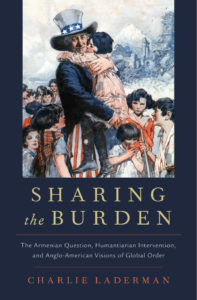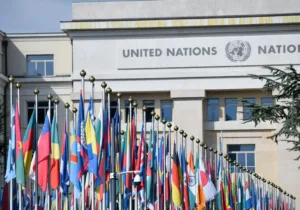In his award-winning new book Sharing the Burden, Charlie Laderman, a historian at King’s College London, skillfully revisits Britain and America’s responses to the Armenian genocide in the World War I era, their ramifications for the international order, and the lessons they hold for humanitarian intervention and the role of religion in international politics today.
The killing of over one million Armenians—by many considered the oldest Christian community in the world—by Ottoman forces in 1917 was an unprecedented tragedy, and according to Theodore Roosevelt, it was the greatest crime of the First World War. However, events of the war have often overshadowed it: the horrors on the Western Front, the Russian Revolution, the collapse of the German, Austro-Hungarian, and Ottoman Empires, and perhaps most importantly, the rise of the United States to global leadership and the subsequent refashioning of the international order.

However, Laderman shows that many of these developments, and especially America’s rise to international leadership, cannot be fully understood without paying greater attention to the Armenian question. Indeed, his book provides a thoroughly researched and highly compelling account of how the Armenian question acted as a catalyst for an emerging American-British geopolitical alliance and the United States’ rise as a predominant actor in the international arena. Moreover, Laderman shows that the Armenian question remains a highly relevant case study for policymakers and observers who seek to understand the dilemmas surrounding humanitarian interventions and the roles of non-state actors in international politics.
Based on careful archival research, the book covers a considerable timespan from the late-nineteenth century, WWI, and to the early 1920s. After briefly examining how and why the once-powerful Ottomans increasingly persecuted Armenian Christians, whom they began to consider as a potential “fifth column” of European powers in the late-nineteenth century, Laderman’s focus thereafter remains on the American and British reactions. In particular, Laderman discusses how the Armenians’ plight rose to ever greater prominence in the American public debate and became a central preoccupation not just for American missionaries and philanthropists but also for policymakers, most prominently Presidents Theodore Roosevelt and Woodrow Wilson.
In so doing, Laderman impressively weaves together numerous strands and actors shaping US foreign policy. A student of geopolitics who learned from masters like Paul Kennedy at Yale and Brendan Simms at Cambridge, Laderman demonstrates the decisive role material hard power played in defining the opportunities and limitations for British and US foreign policy. For instance, largely because of Britain’s imperial crisis, British policymakers pleaded for an Anglo-American colonial alliance and rediscovered a shared Anglo-Saxon civilization as fundamental for a new world order. For them, jointly protecting the Armenians was only a first step to a broader regime of humanitarian interventions and an Anglo-Saxon world order. Similarly, America’s sense of global responsibility and humanitarian duty toward the Armenians expanded in lockstep with its own growing material power and geopolitical security.
However, Laderman also stresses that geopolitics and hard power are not the whole story. Rather, he uses numerous archival sources to reveal the critical importance of factors like public opinion, religion, transnational non-state actors, and leaders’ personal agency. Significantly, he demonstrates that such actors had a greater degree of freedom and agency to shape America’s foreign policy due to the country’s growing geopolitical security. The Armenian question is a revealing example of this dynamic. Rather than the paths of Bismarck-style “realpolitik” and narrowly defined “national interests,” which governed European great power politics for centuries, a more volatile mix of moral, ideological, religious, and personal factors shaped America’s reactions. The plight of the Armenians hence played a central part in the case that missionaries, philanthropists, public commentators, and politicians made for American international leadership. For instance, they largely justified America’s intervention against the Spanish in Cuba and the Philippines as a humanitarian intervention in “America’s Armenia.” These actors also used similar rhetoric for US diplomatic involvement against the Belgians in Congo. Laderman further shows how a religiously motivated, Protestant sense of humanitarian responsibility for the Armenians drove Roosevelt to pursue plans for an Anglo-American colonial alliance and inspired Wilson’s vision of a post-WWI world order where nations had self-determination.
Laderman’s account demonstrates the dilemmas associated with such domestic, personal, ideological, and religious drivers of foreign policy. When discussing Wilson’s failure to summon sufficient public and congressional support for his League of Nations and America’s mandate in Armenia, the book shows a conundrum. A nation that has the geopolitical “luxury” to base its foreign policy on public moods, leaders’ personal principles, or moral ideals rather than self-interested necessity might oscillate suddenly between universalist interventionism and nationalist isolationism. It is therefore less predictable in the international system. British policymakers, who had counted on American support to establish a new Anglo-Saxon post-war order, experienced this problem in 1919. In a much more painful way, Armenians, who had hoped that American protection would save them from further massacres and repressions after the war, suffered when the United States failed to take up its international mandate over Armenia.
Given Laderman’s outstanding job in presenting these countervailing and complex drivers of US foreign policy, there is little to criticize in the book. Some observers might have liked to see a more explicit application of the same analysis of geopolitical and domestic factors to British or other European countries’ foreign policy. For instance, in the book’s narrative considerations of national self-interest and realpolitik appear to drive London’s policies. However, as scholars like Niall Ferguson and Christopher Clark show (and as Laderman himself often implicitly references), British foreign policy itself shifted from a narrow self-interest approach during its imperial crises in the 1880s and 1890s. Britain then adopted a more ideology-based approach once its Entente Cordiale with France and its understandings with Japan and the United States seemed to assure Britain’s geopolitical position. Fortunately, Laderman’s analysis provides the tools and framework for such a future analysis of other nations’ foreign policies.
Moreover, such minor desiderata take nothing from Sharing the Burden’s truly visionary presentation of the Armenian question as a precursor for the future dilemmas of humanitarian intervention in general and of American global leadership in particular. At a moment when the Trump administration is withdrawing troops from Germany seemingly against its own national self-interest, and primarily to punish its old allies in Berlin, and when the world is closely watching the outcome of the American presidential election, Laderman’s book will be highly instructive for international observers and leaders. It will help them understand not only America’s ability to conduct a foreign policy more selfless and moral than any other nation’s, but also how it can become the subject of unexpected mood shifts that make it prone to both adventurism and sudden retreats. Moreover, the book will remain an essential read for current and future American policymakers as they reflect on their personal leadership’s potential and limitations, the factors driving their nation’s willingness to engage the world, and the risks that come with “sharing the burden” of international leadership and humanitarian intervention.







 Sponsor a student for Christianity & National Security 2024
Sponsor a student for Christianity & National Security 2024